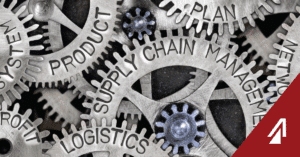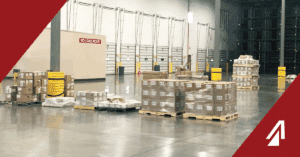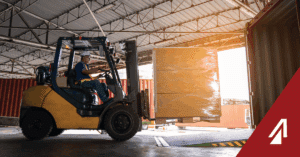In the world of cross-border logistics, few routes are more dynamic or misunderstood than the US-Mexico corridor. With over $1.7 billion in goods flowing between the two countries daily, it’s one of the most vital trade lanes in the global economy. And yet, despite its importance, many logistics providers continue to mismanage this lane by relying on assumptions, outdated practices, or one-size-fits-all strategies.
At ProTrans, we’ve built our business on getting the US-Mexico border right. We’ve seen firsthand how the most minor oversights can lead to customs delays, missed delivery windows, and massive downstream disruption, especially in time-sensitive industries like automotive and complex manufacturing. Here are the most common things logistics providers get wrong about the US-Mexico border—and how to avoid the pitfalls.
Myth #1: “It’s Just Another Domestic Route With Extra Paperwork”
One of the biggest misconceptions is that cross-border freight is simply domestic freight with added customs documentation. This mindset leads to underestimating the planning, coordination, and control required.
The Reality: Cross-border freight requires a different logistics architecture entirely. It’s a unique ecosystem requiring a specialized understanding of regulatory, procedural, and cultural nuances. It also involves coordinating between multiple providers—U.S. carriers, Mexican carriers, drayage providers, customs brokers on both sides of the border, and often warehouse operators.
Many U.S.-based providers assume that moving freight into or out of Mexico just requires adding customs paperwork to a domestic shipment. In reality, customs regulations, bilingual coordination, document timing, security protocols, and staging requirements make it far more complex than domestic transportation.
Documentation alone differs significantly. The pedimento in Mexico, for example, isn’t just a customs form; it’s a legal document tied to the importer’s tax obligations. The Mexican government also recently implemented the requirement of an Automatic Export Notice for specific goods at Mexican customs, which requires exporters to send a request at least 10 days before the need for customs clearance.
Myth #2: “You Can Solve Cross-Border Problems With Price-Driven Brokerage”
Many providers treat cross-border logistics like a price game, chasing the lowest cost carrier and sacrificing stability for short-term savings.
The Reality: This approach almost always leads to poor communication, unreliable service, and zero accountability at the border. Cross-border success hinges on brokers who specialize in U.S.-Mexico trade and understand the complexity and time requirements on both sides of the border.
Many logistics providers select customs brokers based solely on price or existing domestic relationships. But effective customs clearance between the U.S. and Mexico demands deep familiarity with trade programs (IMMEX, USMCA, OEA), import/export licensing, and border-specific processes like in-bond movements and CTPAT certification.
Shippers need brokers who can proactively flag compliance risks, communicate with both U.S. CBP and Mexican SAT, and collaborate with carriers to minimize clearance times. A good broker doesn’t just process paperwork; they advise on structure, documentation accuracy, and risk mitigation.
Myth #3: “Technology Alone Can Fix Border Logistics”
Tech-enabled brokers often promise full automation and visibility as a silver bullet. While good tech is essential, it can’t overcome structural or human execution gaps.
The Reality: Border success requires both smart systems and operational expertise. Tech is a critical tool, but without strong operational execution, even the best platforms fall short.
In recent years, tech-enabled brokers and digital freight platforms have flooded the market with promises of “frictionless” cross-border logistics. They feature dashboards with real-time visibility, AI-driven tracking, automated customs documentation, and predictive ETAs—as if software alone can untangle the complex web of U.S.-Mexico freight.
The truth is, however, that technology is only as good as the people and processes behind it. The U.S.-Mexico border involves dozens of variables that are still reliant on human coordination and physical infrastructure—customs agents, inspectors, transload facility staff, Mexican brokers, drayage drivers, and carriers who may not be digitally connected at all. Even the most advanced platforms can’t prevent delays if your broker misses a document, if your carrier lacks CTPAT certification, or if the transload yard is backlogged.
Myth #4: “Northbound and Southbound Logistics Are Basically the Same”
Some providers assume cross-border strategies can be mirrored in both directions, overlooking the distinct challenges and rules of each direction.
The Reality: Northbound and southbound cross-border logistics face very different regulatory, cultural, and timing challenges. Mirroring strategies from one direction to another and not thoroughly understanding the fundamental differences often leads to costly mistakes and drastic inefficiency.
On the surface, the mechanics may seem similar—drayage to the border, transloading, customs clearance, and linehaul. In practice, however, the two directions operate under very different constraints and dynamics. Success at the U.S.-Mexico border means designing logistics strategies tailored to each direction.
In cross-border logistics, symmetry is not a strategy; precision is. Providers who understand and plan for these differences deliver faster transit, fewer compliance issues, and greater overall supply chain stability.
Myth #5: “Only Big Carriers Can Handle Cross-Border Logistics”
Some companies mistakenly believe that large asset-based carriers—those with massive fleets, nationwide terminals, and extensive domestic networks—are the apparent choice for cross-border freight.
The Reality: Size doesn’t equal cross-border expertise, and in reality, smaller specialized logistics partners often outperform large carriers when it comes to navigating the unique complexities at the border. Big asset-based carriers may offer cross-border services, but their size doesn’t guarantee efficiency or transparency. In many cases, they operate through third-party Mexican carriers or rely on third-party brokers and warehouses, similar to non-asset-based providers.
Cross-border success hinges less on size and more on specialization, flexibility, and operational execution. The key is having established relationships with vetted partners on both sides of the border, multilingual operations teams, and deep experience navigating customs procedures, regulatory changes, and manufacturing supply chains.
The handoff between U.S. and Mexican carriers is often one of the most vulnerable points in the supply chain, prone to delays, miscommunication, and poor visibility. A specialized provider with deep, curated relationships, an embedded bilingual staff, and real-time oversight at the transfer points can offer far more reliability than a large, impersonal carrier operation.
Cross-border shipping is not just about linehaul, it’s about managing the entire ecosystem, from customs compliance and transloading to security protocols and end-to-end visibility. Shippers need partners who can navigate regulations across multiple jurisdictions, reduce customs risks, prevent costly shutdowns at manufacturing plants, and provide actionable insights across lanes. This level of service comes from providers who specialize in designing and executing border-specific logistics strategies.
At ProTrans, we’ve been in the US-Mexico freight business for over 30 years. Our model is designed from the ground up for border operations with strategic cross-dock facilities near major border gateways, bilingual execution teams on both sides of the border, in-house compliance and customs specialists, and real-time shipment tracking integrated into our proprietary system.
Cross-border logistics isn’t an afterthought or a bolt-on service at ProTrans; it’s our core strength with consolidation strategies that can be tailored to your specific needs. Contact our team today. Let’s talk about how we can simplify your border operations and engineer better cross-border outcomes.



